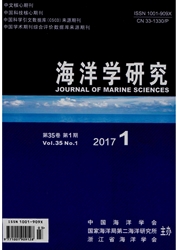

 中文摘要:
中文摘要:
采用X射线荧光光谱仪,对CCLLD27站位富钻结壳中8个主要成矿元素(Mn、Fe、Co、Cu、Si、Al、Ca和Ti元素)含量的分布特征进行了微区扫描和人工分层样品方法的分析,结果表明:(1)成矿元素Mn、Fe、Co和Cu的微区变化很大:Mn与Co元素的微区分布特征相似,而Fe和Cu元素的微区分布特征则相反。主要造岩元素Si和Al的微区分布特征基本类似;Ca元素的微区变化较大,在近底部的基岩层其含量达到最高峰值。Ti元素的微区分布特征与Mn、Co元素微区分布特征接近。(2)微区扫描与人工分层样品两种不同测试方法所得的结果基本一致,说明微区扫描方法具有一定的可靠性,能反映富钴结壳在不同生长时代各成矿元素含量的变化特征。(3)富钴结壳微区元素分布特征的研究,有助于对结壳不同成矿阶段各种不同成矿作用的定性评估。
 英文摘要:
英文摘要:
Micro-distribution features of multi-elements in cobalt-rich crust are studied by an X-ray fluorescence micro-scanning method. Taking the primary cobalt-rich crust of the CCLLD27 site from the Central Pacific Ocean seamounts as an example, the samples were made the thin section by technique of the pressed powder pellets and the powder layered. The sections were determined qualitatively by X-ray fluorescence method moving the sample box, while the powders were determined quantificationally by X-ray fluorescence. The results show that (1)There are obvious differences in micro-distribution features of the main metallogenic elements including Mn. Fe. Co and Cu. Micro-distribution features of Mn and Co are similar, but that of Fe and Cu are opposite. (2)Micro-distribution features of the main rock-forming elements such as Si and AI are similar as well as relationship between Ti and Mn, Co, but there is a sudden change of Ca content near the bottom bedrock. (3) The results based on two different methods indicate that micro- distribution features of multi-elements in cobalt-rich crust are consistent, which proves reliability of the method and reflects the diverse features of element content in cobalt-rich crust during different growth age. (4) The study on micro-distribution features of multi-elements in cobalt-rich crust is helpful to assess contribution of diversified mineralization in different metallogenic stages of the crust. The result proved that the micro-scanning method was reliable compare with the method of the powder layered artificially. Microdistribution features of multi-elements in cobalt-rich crust of the CCLLD27 site from the Central Pacific Ocean seamounts associated with the different environment, growth episode and oxidation-reduction condition, which demonstrated that the hydatogenesis sedimentation, clastic sedimentation and phosphatization were the main geological processes controlling the crust growth. The hydatogenesis sedimentation related to oreforming element (Mn, Co, Ni, C
 同期刊论文项目
同期刊论文项目
 同项目期刊论文
同项目期刊论文
 期刊信息
期刊信息
